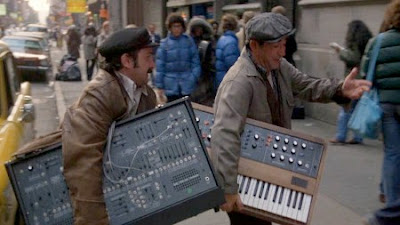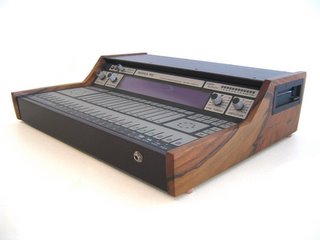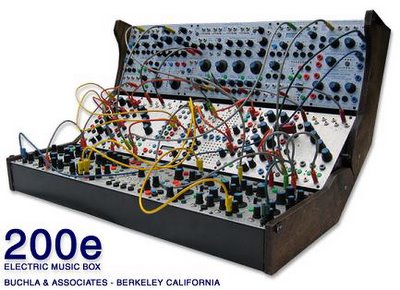This one in via Mike Peake on AH:
"This may exist in other spots on the web. Good, the more the better. Not enough attention is paid to this machine, regardless of any complaints regarding no new modules etc. It's excellent as it is, as the Minimoog is, for those who can make music without the latest bells and whistles. Remembering that the VCF, with resonance at minimum, cuts very nearly as well as the Moog 904a.
VCOVCF2TRESLFO/NoiseVCACabinetTechnosaurusThis was just submitted to Harmony-Central but here it is for you.
Ease of Use:
This is a very easy to use synthesizer owing to clear descriptions and individual module delineation. It's rather more of an East Coast machine along the lines of the Moog Modular, being more of a keyboard player's instrument for jamming than the Buchla-style machines. If you know the Moog and Moog-based systems such as the Synthesizers.com, you'll have no trouble using the Selector.
Perhaps the only suprise is that some CV modulation values are bipolar, requiring a voltage that can swing to the negative, to access certain parameter ranges (very low oscillator frequencies and PW). This works well with the LFOs, which are bipolar, but the envelopes are unipolar (although they can be switched to negative-going, this is still unipolar but in the opposite direction).
I suggest using a Frostwave MIDI to CV converter to drive it, or of course the Technosaurus MIDI/CV module. This is because the oscillators and filters have an impedance that doesn't match the Encore Expressionist I'd planned to use it with.
Features:
Features are limited to the amount of available modules, which does not include a "control module" with manual voltage outs, offsets, etc. Don't worry about the lack of bells and whistles, there is plenty here to keep synthesists and musicians busy owing to the wonderful sonic character and ease of use.
Good features include the fastest (D)ADSRs on the planet (70uS minimum rise time on the Attack). The VCA is built to withstand such speed, and does not click and thump. Reference: The Minimoog will start to click with rise times faster then around 750uS, and the Mini and Modular envs are around 1ms as a result. Due to this, the Selector obviously allows for extreme percussion sounds. The ADSRs can also be switched to AD types as well. Very thoughtful, very handy. The VCA has extreme dynamic range and is very quiet, so you'll end up with powerful percussion and firm, quiet, very dark bass sounds.
The oscillators are very stable, perhaps too much for my ultra-sloppy vintage Moog pinings, but stand at attention when you switch octaves, etc. The hard synch is good-sounding, and there is a thoughtful output on each oscillator for driving others in HS, so that you don't have to mult out an audio waveform to attain it. The pulse waveforms are very stable, even at the extreme values.
The oscillators are similar to the Moog in that they are not incredibly loud, and as such, don't do extremely deep FM. I haven't using a VCA to try boosting the gain on one yet... The LFOs have high output levels, and go up to around 2KHz, so it's easy to use them for nice FM effects. They are also very wide-range, so you can cross-modulate their CVs from nearly standing still, up into the audio ranges. Very nice. I despise LFOs with "range" switching, which always seems to be right in the middle of a place I wish to modulate through, so these are very pleasing.
The Sample and Hold is extremely stable; I know that Jurg is very happy with it, if he'll pardon me for saying so. It features external and internal clock and sampling source. You can drive it with the LFOs and sample the LFO module based Noise source, and produce modulations that will vary across the entire audible range (very wide CV swings). You do not have to be polite here if you do not wish to be. The S/H module has a smooth random source which is nice to use as the sample input as well. It's not the Buchla SOU, but it's musical and useful (which is how I'd characterize this entire synth).
The envelopes may be driven from the LFOs. A varying trigger voltage produces varying envelope output levels (I used the SH output into the triggers for the amplitude-varying drum sounds in my track "Seance". Search Soundclick.com for that if you're intersted.).
The TRES is an excellent module, both sonically and functionally. Although each band is only variable from 32Hz through 8KHz, each is individually controlled by CV, has individual resonance up to and including self-oscillation, and individual volume. Then the overall volume may be modulated by CV if you wish. There is a handy On/Off switch if you want to tune your oscillators to intervals etc. in the midst of a complicated patch, then switch the RES back in.
The TRES is very musical. I love the way it sounds. I applaud Cwejman and others for their new multiple CV resonator modules, but I prefer the resonant character of the TRES over the MP3s that I've heard. It can sound woody, phasey, whispery, and outright nasty as well. It's the key to the male choral sound I like so much, which requires different CV modulation to two of the bands, as well as each band sitting right at the edge of self-oscillation (that magic place that the digital gear has yet to master).
Very nice are the mults on each module where there is space, such as the TRES. Also nice are the multiple inputs on the Filter and TRES, meant to use as unity-gain intput mixing (the oscillators waveforms have individual volumes!). Multiple outs on the TRES etc. are nice too, for easily patching to multiple destinations, ala' the Buchla!
Sound:
The sounds are very good, although the envelopes or the VCA slopes have their own character, a touch off of what I'm used to on the Moog. It's a very interesting instrument to play, and to find new characters in the filter and TRES. Note: The 12dB Filter 2, with the resonance down, cuts very nearly as well as the Moog 904a, which is my standard for happiness. The filter sounds great, and does very interesting audio-rate FM that sound like no other filter I've used (in a good way, of course).
It's a very responsive instrument. You'll need a CV converter with a built-in LFO, however, as it has no DC-capable VCA.
I am very happy with how easily musical it sounds, and knowing that there is much more there waiting to be found.
Reliability:
The envelopes had a mod, a small daughter board, to ease the load on the power supply. This is because they drain the power supplies... I chose a supply with plenty more amps than the system would require, being a believer in headroom anyway.
My fifth envelope has burned up two chips twice now. You cannot fire all five at once. To be very fair, Jurg has sent out replacement parts in no time flat when I've asked. I have full faith in him and the company in support of the product.
This is the only ugly aspect of this beautiful synth. However, I would not turn down a date with that supermodel, the one with the mole, whose name I can't remember, the smart one who was on Politically Incorrect with Bill Maher, just for the fact that she has a mole...
I bought the system knowing about this, and it's not a big problem. It's disappointing to not be able to fire all five envelopes at once, but I'll survive by creating two individual sounds on the one instrument, that fire individually. And I know that Jurg is there if the need should arise.
Otherwise, the machine has been absolutely brilliant. No bad jacks, no bad pots, no dirty pots after several years of use, etc. The Zebra patch cords I bought from him with the system have never worn out either.
There is an overall cage for the modules inside the case; each module slides in on guides and a socket seats at the rear; machining of the front panels is akin to the System 700, in that it's really good. Very tight. In comparison, the original Moog modules were sometimes as sloppy as their pitches. I don't worry that the PCBs would suffer injury unless the entire case were to be somehow crushed.
Customer support:
Jurg is one of the good guys and deserves your attention and respect. I'm happy to have chosen his synth, and having had contact with him.
Conclusion:
The TRES and filter self-oscillate but only if there is an audio input going on. This is a bit unusual, and limits certain things, however, that is very very minor. It would be nice if the TRES had additional 1V/8va inputs, to ease situations where you want instant keyboard tracking.
I'd certainly buy another, and would add to my current system given the chance. I recommend it to anyone who is into modular synthesis, as the filters and TRES are still unlike other systems.
Looking for a slightly different sonic character???
It's been here since 1996.
A note: System C and D owners know that the empty space in the middle rack can be filled with Eurack-compatible modules. Analogue Systems make a nice LFO/DC VCA keyboard module that would be quite nice in there. Also, a "control" module."

 "It has been rumored that there are 12. I have heard that number a bit higher and a bit lower depending on who you ask. There is a Buchla 700 Yahoo group for enthusiasts so there has to be at least a few of them. It is an awesome and truly unique piece of synthesizer gear.
"It has been rumored that there are 12. I have heard that number a bit higher and a bit lower depending on who you ask. There is a Buchla 700 Yahoo group for enthusiasts so there has to be at least a few of them. It is an awesome and truly unique piece of synthesizer gear.



















































